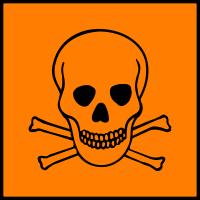|
Storage Condition
|
|
Room Temperature (15-30°C), Desiccate, Protect from light
|
 Show
data source Show
data source
|
|
|
Storage Warning
|
|
Light Sensitive & Hygroscopic
|
 Show
data source Show
data source
|
|
|
RTECS
|
|
VA9275000
|
 Show
data source Show
data source
|
|
|
European Hazard Symbols
|
 Corrosive (C) Corrosive (C)
|
 Show
data source Show
data source
|
 Nature polluting (N) Nature polluting (N)
|
 Show
data source Show
data source
|
 Toxic (T) Toxic (T)
|
 Show
data source Show
data source
|
 Harmful (Xn) Harmful (Xn)
|
 Show
data source Show
data source
|
|
|
UN Number
|
|
2656
|
 Show
data source Show
data source
|
|
UN2656
|
 Show
data source Show
data source
|
|
|
MSDS Link
|
|
|
German water hazard class
|
|
2
|
 Show
data source Show
data source
|
|
|
Hazard Class
|
|
6.1
|
 Show
data source Show
data source
|
|
|
Packing Group
|
|
3
|
 Show
data source Show
data source
|
|
III
|
 Show
data source Show
data source
|
|
|
Australian Hazchem
|
|
3Z
|
 Show
data source Show
data source
|
|
|
Risk Statements
|
|
45-21/22-36/38-51/53-68
|
 Show
data source Show
data source
|
|
45-21/22-36/38-68-51/53
|
 Show
data source Show
data source
|
|
R:22-27-34
|
 Show
data source Show
data source
|
|
R21, R22
|
 Show
data source Show
data source
|
|
|
Safety Statements
|
|
53-45-61
|
 Show
data source Show
data source
|
|
S:26-27/28-36/37/39-46-64
|
 Show
data source Show
data source
|
|
S26, S27, S28, S29, S30, S31, S32, S33, S34, S35, S36
|
 Show
data source Show
data source
|
|
|
EU Classification
|
|
T1
|
 Show
data source Show
data source
|
|
|
EU Hazard Identification Number
|
|
6.1B
|
 Show
data source Show
data source
|
|
|
Emergency Response Guidebook(ERG) Number
|
|
154
|
 Show
data source Show
data source
|
|
|
TSCA Listed
|
|
是
|
 Show
data source Show
data source
|
|
|
GHS Pictograms
|

|
 Show
data source Show
data source
|

|
 Show
data source Show
data source
|

|
 Show
data source Show
data source
|
|
|
GHS Signal Word
|
|
Danger
|
 Show
data source Show
data source
|
|
|
NFPA704
|
|
|
 Show
data source Show
data source
|
|
|
LD50
|
|
331 mg/kg
|
 Show
data source Show
data source
|
|
|
GHS Hazard statements
|
|
H301-H312-H315-H319-H341-H350-H411
|
 Show
data source Show
data source
|
|
H302-H311-H315-H319-H341-H350-H411
|
 Show
data source Show
data source
|
|
H311-H302-H315-H319-H350-H341-H411-H401
|
 Show
data source Show
data source
|
|
|
GHS Precautionary statements
|
|
P201-P273-P280-P301 + P310-P305 + P351 + P338-P308 + P313
|
 Show
data source Show
data source
|
|
P201-P273-P280-P305 + P351 + P338-P308 + P313
|
 Show
data source Show
data source
|
|
P280-P305+P351+P338-P361-P302+P352-P405-P501A
|
 Show
data source Show
data source
|
|
|
Personal Protective Equipment
|
|
Eyeshields, Faceshields, full-face respirator (US), Gloves, multi-purpose combination respirator cartridge (US), type ABEK (EN14387) respirator filter
|
 Show
data source Show
data source
|
|
|
RID/ADR
|
|
UN 2656 6.1/PG 3
|
 Show
data source Show
data source
|
|